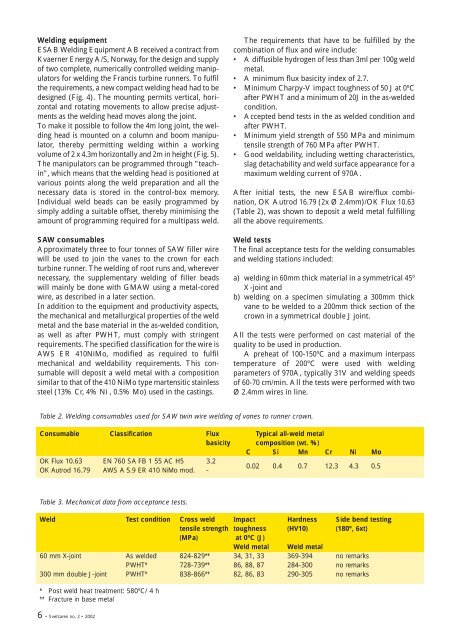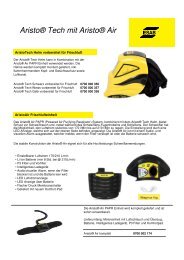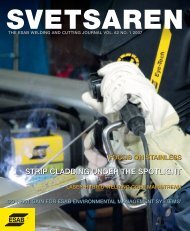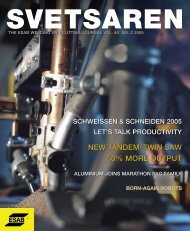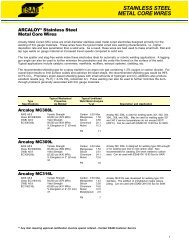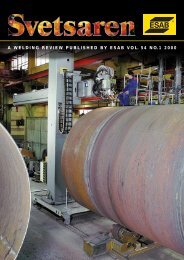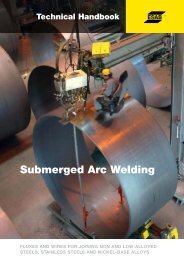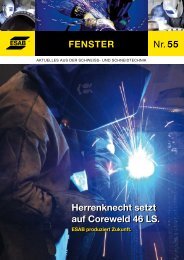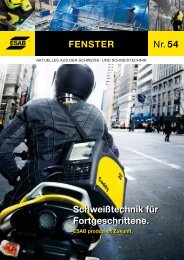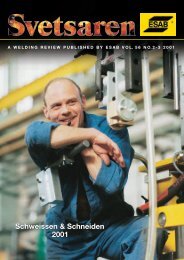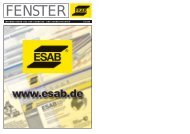Svetsaren_nr2 definitief (Page 1) - Esab
Svetsaren_nr2 definitief (Page 1) - Esab
Svetsaren_nr2 definitief (Page 1) - Esab
You also want an ePaper? Increase the reach of your titles
YUMPU automatically turns print PDFs into web optimized ePapers that Google loves.
Welding equipment<br />
ESAB Welding Equipment AB received a contract from<br />
Kvaerner Energy A/S, Norway, for the design and supply<br />
of two complete, numerically controlled welding manipulators<br />
for welding the Francis turbine runners. To fulfil<br />
the requirements, a new compact welding head had to be<br />
designed (Fig. 4). The mounting permits vertical, horizontal<br />
and rotating movements to allow precise adjustments<br />
as the welding head moves along the joint.<br />
To make it possible to follow the 4m long joint, the welding<br />
head is mounted on a column and boom manipulator,<br />
thereby permitting welding within a working<br />
volume of 2 x 4.3m horizontally and 2m in height (Fig. 5).<br />
The manipulators can be programmed through "teachin",<br />
which means that the welding head is positioned at<br />
various points along the weld preparation and all the<br />
necessary data is stored in the control-box memory.<br />
Individual weld beads can be easily programmed by<br />
simply adding a suitable offset, thereby minimising the<br />
amount of programming required for a multipass weld.<br />
SAW consumables<br />
Approximately three to four tonnes of SAW filler wire<br />
will be used to join the vanes to the crown for each<br />
turbine runner. The welding of root runs and, wherever<br />
necessary, the supplementary welding of filler beads<br />
will mainly be done with GMAW using a metal-cored<br />
wire, as described in a later section.<br />
In addition to the equipment and productivity aspects,<br />
the mechanical and metallurgical properties of the weld<br />
metal and the base material in the as-welded condition,<br />
as well as after PWHT, must comply with stringent<br />
requirements. The specified classification for the wire is<br />
AWS ER 410NiMo, modified as required to fulfil<br />
mechanical and weldability requirements. This consumable<br />
will deposit a weld metal with a composition<br />
similar to that of the 410 NiMo type martensitic stainless<br />
steel (13% Cr, 4% Ni , 0.5% Mo) used in the castings.<br />
The requirements that have to be fulfilled by the<br />
combination of flux and wire include:<br />
• A diffusible hydrogen of less than 3ml per 100g weld<br />
metal.<br />
• A minimum flux basicity index of 2.7.<br />
• Minimum Charpy-V impact toughness of 50 J at 0ºC<br />
after PWHT and a minimum of 20J in the as-welded<br />
condition.<br />
• Accepted bend tests in the as welded condition and<br />
after PWHT.<br />
• Minimum yield strength of 550 MPa and minimum<br />
tensile strength of 760 MPa after PWHT.<br />
• Good weldability, including wetting characteristics,<br />
slag detachability and weld surface appearance for a<br />
maximum welding current of 970A.<br />
After initial tests, the new ESAB wire/flux combination,<br />
OK Autrod 16.79 (2x Ø 2.4mm)/OK Flux 10.63<br />
(Table 2), was shown to deposit a weld metal fulfilling<br />
all the above requirements.<br />
Weld tests<br />
The final acceptance tests for the welding consumables<br />
and welding stations included:<br />
a) welding in 60mm thick material in a symmetrical 45º<br />
X-joint and<br />
b) welding on a specimen simulating a 300mm thick<br />
vane to be welded to a 200mm thick section of the<br />
crown in a symmetrical double J joint.<br />
All the tests were performed on cast material of the<br />
quality to be used in production.<br />
A preheat of 100-150ºC and a maximum interpass<br />
temperature of 200ºC were used with welding<br />
parameters of 970A, typically 31V and welding speeds<br />
of 60-70 cm/min. All the tests were performed with two<br />
Ø 2.4mm wires in line.<br />
Table 2. Welding consumables used for SAW twin wire welding of vanes to runner crown.<br />
Consumable Classification Flux Typical all-weld metal<br />
basicity composition (wt. %)<br />
C Si Mn Cr Ni Mo<br />
OK Flux 10.63 EN 760 SA FB 1 55 AC H5 3.2<br />
OK Autrod 16.79 AWS A 5.9 ER 410 NiMo mod. -<br />
0.02 0.4 0.7 12.3 4.3 0.5<br />
Table 3. Mechanical data from acceptance tests.<br />
Weld Test condition Cross weld Impact Hardness Side bend testing<br />
tensile strength toughness (HV10) (180º, 6xt)<br />
(MPa)<br />
at 0ºC (J)<br />
Weld metal Weld metal<br />
60 mm X-joint As welded 824-829** 34, 31, 33 369-394 no remarks<br />
PWHT* 728-739** 86, 88, 87 284-300 no remarks<br />
300 mm double J-joint PWHT* 838-866** 82, 86, 83 290-305 no remarks<br />
* Post weld heat treatment: 580ºC/ 4 h<br />
** Fracture in base metal<br />
6 • <strong>Svetsaren</strong> no. 2 • 2002


